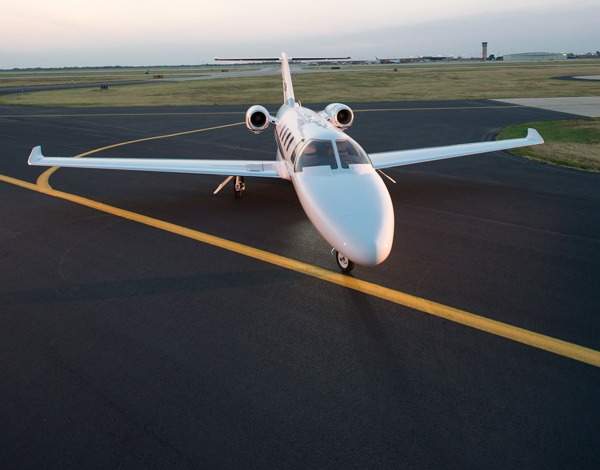
Cessna’s practical Citation M2 is an ideal entry point for any pilot new to jets, writes Ben Griffiths
Everything about the Cessna Citation M2 oozes luxury, simplicity and practicality. The jet is striking to look at, its graceful curves augmented by shining silver leading edges on the wings and engine nacelles. These aren’t there simply to look good but are heated for de-icing purposes.
On the inside the comfortable, ergonomic cockpit is designed for single pilot operations, while for passengers there are two surprisingly voluminous baggage compartments, leather seating for six (seven if one sits next to a single pilot) and even a diminutive onboard toilet, all making for a desirable combination.In performance terms, the M2 compares well against its peers, enjoying 1,956lb of thrust from each of its two Williams FJ44 engines, enabling a climb to 41,000ft in just 24 minutes.
It’s also comfortable flying from high and hot airports while maintaining fuel capacity and is equally happy flying into shorter runways, to get passengers closer to their destinations. Operating costs are attractive, too, coming in at around $1,000 per hour or $2.85 per nautical mile travelled, making this the ideal entry into jet operations for pilots and owner/operators used to flying piston or turboprop types.
For many M2 customers, this is their first jet. Most excitingly of all, the avionics fit-out is a joy. Although I’ve had experience of the Garmin flight deck before, it’s reassuring to have Captain Paul Stapleton in the left-hand seat to show me how to get the best out of this little jet. For take-off I relax in the passenger cabin and enjoy the sensation of power as we line up at Doncaster Sheffield Airport’s runway 20. This is a former RAF station, now home to Cessna’s jet maintenance facility. We need barely any of the almost 3km of runway as the throttles are advanced and the aircraft leaps into the sky.Established in the climb at 10,000ft, I swap seats with co-pilot Mariella Roth-Walraf.
The combination of smaller aircraft and large journalist can mean the skills of a contortionist are needed to install myself in the cockpit. With the M2, however, I settle down with ease and I’m soon being given the tour and control of the autopilot as we continue up to 28,000 feet and head out towards the Irish Sea.
The Garmin G3000 avionics system features three 14in, high-resolution flight displays that can be further split to show more information, such as GPS, Flight Director and Safe Taxi, which shows were you are on the ground when moving around the airport. The screens are controlled by two touchscreen control/display panels. For the generation of pilots weaned on iPads, the M2’s cockpit is a home from home. Unlike some smaller jets, the M2 has a full control yoke. But it doesn’t impede on the view or feel restricted in any way by my legs. The twin throttle control (there’s no auto-throttle on the M2) feels just right in terms of the force required to adjust power settings. Paul graciously tells me I’m doing a good job, so I continue with the descent as the controller routes us towards the instrument approach into Doncaster.
Dark descent
As it’s gloomy on the ground, there’s no view of it from our perch, so it’s definitely an instrument approach. Eyes in the cockpit, I’m following the flight director symbols on my display, reducing our speed gradually as Paul starts to deploy flaps and eventually the landing gear as we get closer to the runway.
The controller vectors us down on to final approach and I’m beginning to think we aren’t going to reach our ‘minimums’ today for a landing – we must be able to view the runway above our decision height. If not, we must advance the throttles, pull up the landing gear and flaps and climb away to try again or divert elsewhere.
Fortunately, the runway lights suddenly appear through the gloom and we’re well above minimums so can continue our approach. Paul disconnects the autopilot and I’m feeding in left rudder and some right aileron to counteract the slight crosswind, all the while making small adjustments to the power to keep our speed nailed at 111 knots.
The runway appears to rear up towards us and Paul’s in my ear with snippets of advice as we coast down final approach. The trailing link undercarriage flatters my landing, and also makes for smooth taxiing.I’m really taken by the M2’s simple systems and evidence of its high reliability is reassuring, along with impressive performance.
This would be an ideal entry point to the world of personal jets for any aspiring pilots looking to take the step up.
Read more









